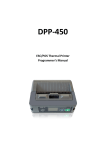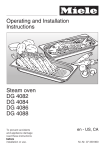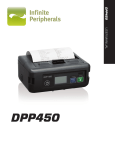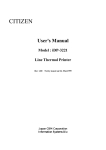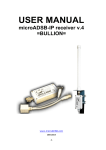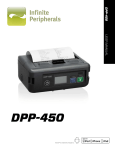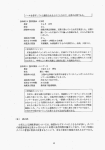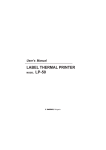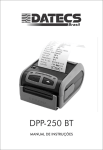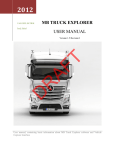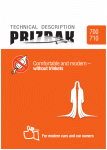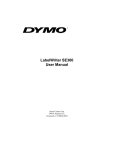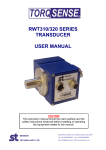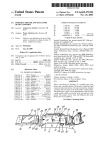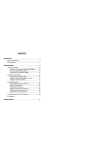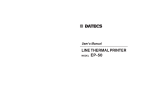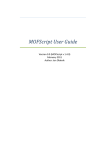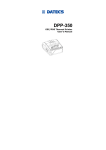Download Page mode
Transcript
1 DATECS DPP-350
User’s Manual
1 DATECS DPP-350
User’s Manual
1
1 DATECS DPP-350
User’s Manual
Introduction
DATECS DPP-350 is a mobile ESC/POS thermal printer with 3-inch wide printing mechanism. It
can be used in dynamic working conditions and its abundant built-in features allow it to be widely used
for different applications. Printer can quickly and easily print text and/or graphics, depending on
customer’s needs – barcodes, logo, etc.
•
•
•
•
•
•
•
•
•
•
Features:
Small and lightweight, for real mobility
High speed and low noise, owing to line thermal print
Easy paper-loading
Can be used with 2 types of thermal paper – 78 mm or 58 mm wide
Long lasting battery – max 30,000 lines per charge
Serial RS232 or USB interfaces
Supports protocol for POS and BARCODE
Capable of printing alpha-numeric and graphical data
Drivers for Pocket PC, Palm OS, Windows and Blackberry
Configuration Options:
9 Bluetooth interface
9 Magnetic Stripe Reader (3 track)
9 Smart Card Reader
9 Reader for contactless RFID cards
9 SD card slot reader
9 Built-in metal belt hook and neck lanyard
2
1 DATECS DPP-350
User’s Manual
Specification
Feature
Specification
Printing Method
Line Thermal dot printing
Printing Head
max 72 mm / 576 dots per line
Paper Feed System
step
Characters per line
48
Dot density
8 x 8 dots/mm (203 dpi)
Print lines per charge
30000
Printing Speed
60 mm/s
Fonts
Font А: 12 x 24 dots
Font B: 9 x 16 dots
Loadable Font C: 12 x 24 dots
Loadable Font D: 9 x 16 dots
Font E (JIS and Shift-JIS): 24 x 24 dots – in Japanese version only.
Font F (GB2312): 24 x 24 dots – in Chinese version only.
Recommended Paper
78 mm x 50 mm diameter
58 mm x 50 mm diameter (option)
Interfaces
RS-232 interface, type RS-232C, max 115200 bps
USB interface, type USB v 1.1, compatible with 2.0
Bluetooth interface (option)
Configuration options
Smart card reader (option), Magnetic stripe reader (option)
Reader for contactless RFID cards (options), reader for SD cards (option)
Emulation
ESC/POS
Barcode printing
EAN 13, EAN 8, UPC-A, UPC-E, CODEBAR, CODE 39, CODE 128, PDF417,
QR Code
Buffer
36864 bytes (Option 131072 bytes)
Power switch
ON/OFF
Battery
Rechargeable battery Li-ion - 7.4 V/2000 mAh
Model: 10AD-E
Adapter
Input: AC 100 – 240 V, 1.3 A, 50/60 Hz
Output: DC 9 V, 1 A
Operation switches
Button LF – Paper feed, Self test, Dump mode
Button ON/OFF- Switch On/Switch OFF
Weight
340 г (w/o paper) or 430 г (with paper)
Dimensions
118 (W) mm X 90 (D) mm X 51 (H) mm
Operating Environment
0~40°C
35~85% RH
Storage Environment
–20~60°C
Reliability
Printing Head – 50 km paper long (printing rate 25% max )
10~90% RH
"Drop" test - upto 110 cm and "Waterproof"
Cables
RS-232 interface cable; mini USB cable А to B cable (option)
3
1 DATECS DPP-350
User’s Manual
About DPP-350
1 – button ON/OFF
2 – button LF (Line Feed)
3 – ON/OFF & Error LED indicating printer status (STATUS)
4 – Charging LED (CHARGE)
5 – AC/DC adapter input
6 – Mini USB port
1 – RS232 port
2 – Reader LED
3 – Smart Card Holder
4 – Magnetic Card Reader
5 – Reader for contactless RFID cards
6 – Paper Cover Lever
7 – Paper Cover
7 – Paper Cover
8 – Thermal Paper Roll
4
1 DATECS DPP-350
User’s Manual
Hardware configuration switches
Switch
Sw1
Sw2
Sw3
Sw4
OFF
78 mm paper/label roll
Continuous paper mode
Hardware protocol
Normal operation mode
ON
58 mm paper/label roll
Label/Black mark mode
Xon/Xoff protocol
Protocol mode
Diagnostic information, dump mode and firmware
updating
•
•
•
•
•
•
•
Holding <LF> button while power on for ~ 0.5 sec (first sound signal) – short
selftest.
Holding <LF> button while power on for ~ 2.5 sec (second sound signal) – start
dump mode. All input data are printed hexadecimal and as text.
Holding <LF> button while power on for ~ 4.5 sec (third sound signal) – long
selftest.
Holding <LF> button while power on for ~ 6.5 sec (forth sound signal) – enter
firmware updating mode for the optional card reader.
Holding <LF> button while power on for more than 8.5 sec (fifth 4-tone sound
signal) – enter firmware updating mode.
Holding <ON> button while power on for ~ 4 sec (first sound signal):
□ If serial cable is connected (RS232 communication) – temporary
forcing 9600 bps serial speed.
□ If no serial cable connected (Bluetooth or USB communication) –
starting a hardware menu for fast Bluetooth pairing info reset.
Holding <ON> button while power on for more than 6 sec – enter hardware
setup mode.
Protocol mode
Protocol mode is active when DIP switch 4 is on. The purpose of this mode is to
give full control over the optional peripherals (MC and smart card reader) and a
stronger real time access to the printer. All input data are sent in packets as described
below. The printer returns an answer to the packet immediately.
Output packet format:
Answer format:
Channel Command LenHi LenLo Data
Channel Status LenHi LenLo Data
Channel:
One byte:
Bits 0 – 6 Channel number (Device type)
Bit 7
0: Send data; 1: Response
Command: One byte with possible value:
5
1 DATECS DPP-350
User’s Manual
0:
Open channel (No action – all channels always open)
1:
Close channel (No action – all channels always open)
2:
Send data
3:
Request data
>4:
Application specific
Status:
One byte:
Bit 0
Bit 1
Bit 2
Bit 3
Bit 4
Bit 5
Bit 6
Bit 7
0
No error
ACK (Packet accepted)
Channel and command OK
Battery OK
Printing head OK
Paper OK
1
Error occured
NACK (Packed not accepted)
Wrong channel or command
Low battery
Printing head too hot
Out of paper
Not defined
Printer busy
Printer ready
Bit 7 is set, if:
• There are unprinted lines in the print buffer.
• There are bytes in the print buffer.
• The printer is executing a macro.
• The printer is executing selftest.
• The button <LF> is pressed – feeding paper.
LenHi:
LenLo:
Data:
High byte of data length of data. 00h to 08h.
Low byte of data length of data. 00h to FFh.
256*LenHi +LenLo data bytes.
The maximum packet length is 2048 bytes.
The answer differs from the command by bit 7 (MSB) in the channel number. If
bit 7 is 0 then it is a command, if it is 1 then it is a response. Bit 0 in the status byte
shows if there was an error accepting or processing the data block. If this bit is 1 the
other bits show the type of the error.
The printer never issues a transmission by itself. It always responds as an answer
to a command. The communication goes like this:
Host – command, Printer – answer; Host – command, Printer – answer; etc.
The defined channels are:
1
Printer.
16 (10h)
Optional card reader.
Commands for the printer channel (1):
Command 2
Send data
The data is copied into the printer’s print buffer. If there’s not enough
space into the print buffer the packet is rejected, and a status byte with
value 3 is returned in the answer.
Command 3
Receive data
6
1 DATECS DPP-350
User’s Manual
If there is data to be transmitted from the printer to the host, it is
transmitted in the data field of the packet, otherwise an empty packet is
received. The application must take care to get the data fast enough from
the output buffer or the data may be corrupt.
Command 4
Get printer status. 5 data bytes returned in response:
BufferHi BufferLo PrStatus Volt Temperature
BufferHi
High byte of the count of free bytes in input
buffer.
BufferLo
Low byte of the count of free bytes in input
buffer.
PrStatus
Printer status. The following bits defined:
Bit 0
Battery low
Bit 1
Too hot
Bit 2
No paper
Volt
The battery voltage in units 0.1V
Temperature The head temperature in degrees Celsius.
If free bytes in input buffer are more than 65535 (FFFFh), then FFFFh
is returned.
Using channel 16 is the only way for full control over the optional card reader.
Communication example (all bytes hexadecimal):
Send data:
>>> 01 02 00 05 11 22 33 44 55
<<< 81 00 00 00
Send data with error:
>>> 01 02 00 05 11 22 33 44 55
<<< 81 01 00 00
>>> 01 02 00 05 11 22 33 44 55
<<< 81 01 00 00
>>> 01 02 00 05 11 22 33 44 55
<<< 81 00 00 00
Receive data:
>>> 01 03 00 00
<<< 81 00 00 00
>>> 01 03 00 00
<<< 81 00 00 04 11 22 33 44
>>> 01 03 00 00
<<< 81 00 00 00
Get status:
>>> 01 04 00 00
<<< 81 00 00 05 3F F8 01 49 27
Page mode
7
1 DATECS DPP-350
User’s Manual
Starting from version 1.40, the printer supports page mode. For this mode is
needed larger RAM, so it is possible, that some of the older printers will not
support it. You can check this using command ESC Z (bit 29.5 will be set if page
mode is supported).
New 13 commands are added in page mode, most of the old command work
differently.
In standard mode the device prints the data after receiving new line command
(LF or CR depending on memory switches) or when the line is wider than the
defined print area.
In page mode the result of incoming commands is forwarded to a reserved
memory area (page). The page place and size is defined using command ESC W.
Command GS T selects the print direction in this page. At the end the collected
information is printed using one of the commands, provided for this. Commands
ESC FF and GS FF print only the currently defined page, but command ESC Z
prints the area between the first and last line containing at least one black point.
All commands except GS L and GS W work in page mode. The centering and
right alignment (command ESC a) is working in the currently defined page width.
List of commands
1
2
3
4
5
6
7
8
9
10
11
12
13
14
15
16
17
18
19
20
21
22
23
24
25
BEL
HT
LF
FF
CR
CAN
ESC FF
ESC RS
ESC SP
ESC #
ESC $
ESC %
ESC &
ESC !
ESC *
ESC +
ESC ESC .
ESC 2
ESC 3
ESC =
ESC ?
ESC @
ESC CAL
ESC D
Sounds the buzzer
Horizontal Tab command
Printing and Paper Feed Command
Printing and paper feeding to the black mark position
Print one line Command
Canceling print data in page mode
Print data in page mode
Sounds the buzzer
Setting character spacing
Setting EURO symbol position
Specifying the absolute horizontal position for printing
Selecting/Canceling the printing of downloaded user character sets
Selecting user character set
Specifying printing mode of text data
Printing graphical data
Switch OFF the printer
Selecting/Canceling underlining
Printing self test/diagnostic information
Specifying 1/6-inch line feed rate
Specifying line feed rate n/203 inches
Data input control
Reading magnetic stripe card
Initializing the printer
Black mark mode sensor calibration
Setting horizontal tab position
8
1 DATECS DPP-350
26
27
28
29
30
31
32
33
34
35
36
37
38
39
40
41
42
43
44
45
46
47
48
49
50
51
52
53
54
55
56
57
58
59
60
61
62
63
64
65
66
67
68
69
70
71
72
ESC E
ESC F
ESC G
ESC I
ESC J
ESC L
ESC N
ESC R
ESC S
ESC T
ESC U
ESC V
ESC W
ESC X
ESC Y
ESC Z
ESC \
ESC ]
ESC ^
ESC _
ESC `
ESC a
ESC c5
ESC d
ESC i
ESC o
ESC pair=
ESC pwd=
ESC r
ESC u
ESC v
ESC x
ESC y
ESC {
GS FF
GS $
GS )
GS *
GS /
GS :
GS B
GS C
GS H
GS L
GS Q
GS R
GS S
User’s Manual
Specifying/Canceling highlighting
Filling or inverting page area in page mode
Specifying/Canceling highlighting
Specifying/Canceling Italic print
Printing and Paper feed n/203 inches
Selecting page mode
Reading programmed serial number
Selecting country
Specifying speed (bps) of serial port
Printing short self test
Selecting/Canceling underlined printing
Selecting/Canceling printing 90°- right turned characters
Defining the print area in page mode
Specifying max printing speed
Selecting intensity level
Returning diagnostic information
Specifying relative horizontal position
Loading of the default settings stored in Flash memory
Saving current settings in Flash memory
Loading factory settings
Reading Battery Voltage and Thermal head temperature
Aligning of characters
Enabling/Disabling the functioning of button LF
Printing and feeding paper by n- lines
Feeding paper backwards
Temporarily feeding paper forward
Enabling/Disabling PAIRING info saving in Bluetooth mode
Programming new Bluetooth password (PIN)
Full command for sounding buzzer
Selecting code table
Transmitting the printer status
Setting time interval for automatic Power OFF
Set USB response strings
Enabling/Canceling printing of 180° turned characters
Printing in page mode and returning to standard mode
Specifying the absolute vertical position in page mode
Setting printer flags (memory switches)
Defining the Downloaded Bit Image (logo)
Printing the Downloaded Bit Image
Starting/ending macro definitions
Enabling/Disabling inverse print (white on black)
Read the Real Time Clock
Selecting Printing position of HRI Code
Setting left margin
Printing 2-D barcodes
Filling or inverting a rectangle in page mode
Selecting 2-D barcode cell size
9
1 DATECS DPP-350
73
74
75
76
77
78
79
80
81
82
83
84
85
86
GS T
GS U
GS W
GS X
GS Z
GS \
GS ^
GS c
GS f
GS h
GS k
GS p
GS q
GS w
User’s Manual
Selecting the print direction in page mode
Selecting the standard mode
Setting print area width
Draw a box in page mode
Print the non blank page area in page mode
Specifying the relative vertical position in page mode
Executing macro
Set the Real Time Clock
Setting the font of HRI code
Setting height of the barcode
Printing the barcode
Settings for 2D barcode PDF417
Height of the module of 2D barcode PDF417
Selecting the horizontal size (Scale factor) of the barcode
Asian Languages Support
87
88
89
90
91
92
93
FS !
FS &
FS FS .
FS C
FS S
FS W
Specifying printing mode of two-byte text data
Selecting two-byte text mode (JIS or GB2312)
Selecting/Canceling underline mode for two-byte text mode
Canceling two-byte text mode
Selecting Shift-JIS mode (Japanese version only)
Specifying character spacing for two-byte text mode
Selecting double size characters for two-byte text mode
Command Details
1. Sounds the Buzzer (BEL)
Code: [07h]
By executing this command the buzzer will beep
2. Horizontal Tab command (HT)
Code: [09h]
Shifts the printing position to the next horizontal tab position. The horizontal tab
position is set by ESC D. By default the horizontal tab position is at each 8th character (in
9th, 17th, 25th column) from FONT A.
3. Printing and Paper Feed Command (LF)
Code: [0Ah]
Prints data stored in input buffer and feeds paper with one line (the height of a line
that has been set).
4. Printing and paper feeding to the black mark position (FF)
10
1 DATECS DPP-350
User’s Manual
Code: [0Ch]
This command prints the data in the printer buffer and searches for black mark. It is
ignored if black mark mode is not specified.
Note for Black Mark Function
- Error detection at black mark mode
Paper end is not checked during printing and also black mark is not checked.
After receiving FF command, printer checks black mark and paper end. Once black
is detected and white is detected again within 6 mm paper feed, it is determined as
black mark. If the white is not detected within 6 mm paper feed, it is determined as
paper end.
After receiving FF command, if printer cannot detect black mark by feeding paper
for 360 mm, printer recognizes it as black mark detecting error. And the result is
same as detecting paper end.
To release the error, it is necessary to put correct paper and press LF switch long.
- LF switch operation in black mark mode
Press short:
Feed one line
Press longer than 1 sec.:
Feed paper to find next black mark.
(Same as sending FF command)
- Remarks for programming
As it is possible to print on black mark, if user does not want to print on the black
mark, it have to be taken care by user side program
- Remarks on handling
If the paper cover is open in black mark mode, there is a possibility to recognize it as
detecting black mark.
5. Print one line Command (CR)
Code: [0Dh]
This command is ignored or its action is the same as LF depending on the state of
memory switches set with last command GS ).
6. Canceling print data in page mode (CAN)
Code: [18h]
The command clears the currently selected page area and sets current print position to
coordinates (0, 0) in the current page (depending on the currently selected print direction
with command GS T).
The command is not valid in standard mode.
7. Print data in page mode (ESC FF)
Code: [1Bh] + [0Ch]
The command executes a batch printout of the data, mapped in the currently selected
page. The printer continues to work in page mode and data is not destroyed, so the
command may be executed many times.
The command is not valid in standard mode.
11
1 DATECS DPP-350
User’s Manual
8. Sounds the buzzer (ESC RS)
Code: [1Bh] + [1Eh]
By executing this command the buzzer will beep.
9. Setting character spacing (ESC SP)
Code: [1Вh] + [20h] + n
[0 <= n < 40h]
The rightward space amount is set in dot unit (1/203 inch unit). The initial value is
n=0. When the font size is doubled the space between characters is also doubled. Possible
values are from 0 to 63 dots.
10. Specifying the EURO symbol position (ESC #)
Code: [1Bh] + [23h] + n
0 <= n <= FF
The ASCII code of EURO symbol
This command forces the EURO symbol to appear at the selected ASCII code. So
when a code table without EURO symbol is selected, the user can use this symbol at the
desired place. The original character with this ASCII code becomes inaccessible until
redefinition using the same command.
ASCII codes from 00H to 1FH disable EURO substitution and the selected code table is
printed unchanged.
Default value is 00H (EURO substitution disabled).
11. Specifying the absolute horizontal position for printing (ESC $)
Code: [1Bh] + [24h] + n1 + n2
0 <= n1 <= FF
Horizontal shifting in dots (least significant byte LSB)
0 <= n2 <= 02
Horizontal shifting in dots (most significant byte MSB)
The shifting is n1 + 256*n2 dots. Specifying beyond the line end is ignored.
12. Selecting/Canceling the printing of downloaded user character sets (ESC %)
Code: [1Bh] + [25h] + n
n can be from 0 to 255, but only the Least significant bit (LSB) is important:
0 canceling selection of user characters (default characters set is chosen)
1 loaded user character set is chosen
Character set is defined by the command ESC &. The chosen character set is kept
even if printer is switched off.
13. Selecting user character set (ESC &)
Code: [1Bh] + [26h] + а + n + m + D11 + … + D(m-n+1)k
20h <= n <= m FFh
a is the number of the sub-command and can be:
0 or ‘0’: Copies internal character set A over user character set A. All parameters
after the number of the command are omitted.
12
1 DATECS DPP-350
User’s Manual
1 or ‘1’: Copies internal character set B over user character set B. All parameters
after the number of the command are omitted.
2 or ‘2’: Defines a sequence of characters for Font A (12x24)
3 or ‘3’: Defines a sequence of characters for Font B (9x16)
4 or ‘4’: Defines a sequence of characters for Font B (9x16)
n is the ASCII code of the first, m ASCII code of the last of the (m-n+1) consecutive
characters. When only one symbol is defined m=n.
With Dij are described the data for the characters. Each character from Font A is
defined with 48 bytes. Each character from Font B is defined with 16 bytes for
subcommand 3 (the 9-th horizontal bit is always white) and with 32 bytes for
subcommand 4 (2 bytes for each horizontal row, only the most significant bit of the
second byte is used).
The data for character set (font) A is composed from left to right and from top to
bottom with two bytes for each horizontal line. From the second byte only the first nibble
(the most significant 4 bits) is valid. Each bit defines one dot, 1 is for black, starting from
the most significant bit.
Downloaded characters are valid even after switching off the printer.
14. Specifying printing mode of text data (ESC !)
Code: [1Вh] + [21h] + n
Data is given in binary code.
Each n bit indicates the following:
Bit
0
1
2
3
4
5
6
7
Function
Character Font
Highlighting
Double Height
Double Width
Underline
Value 0
А (12x24)
Undefined
Undefined
Canceled
Canceled
Canceled
Undefined
Canceled
Value 1
B (9x16)
Specified
Specified
Specified
Specified
An underline is attached to the full character width, which, however, is not attached
to the part having been skipped by the horizontal tab. Neither is it attached to 90°-rightturned characters.
The underline width is as having been specified by (ESC -). (The default setting is 1
dot width.)
Highlighting is valid for character font A (12x24) and font B (9x16). It is not
recommended to be used for font B because text is not readable. If at same time are given
double height and/or double width and to 90°-right-turning of character, then the
sequense of execution is as follows:
- characters is doubled in the direction indicated
- character is turned at 90°-right-angle
13
1 DATECS DPP-350
User’s Manual
15. Printing graphical data (ESC *)
Code: [1Bh] + [2Ah] + m + n1 + n2 + D1+ … + Dk
m (0 ,1 ,20h или 21h) Graphics mode (see table below).
0 <= n1 <= FFh
specifies the number of dots in horizontal line (LSB).
0 <= n2 <= 09h
specifies the number of dots in horizontal line (MSB).
Di (i from 1 to k)
bit image data.
The number of dots in horizontal direction is n1+n2*256.
Number of data bytes k is n1 + 256*n2 for modes 0 and 1, and (n1+256*n2)*3 for
20h and 21h.
The bits subject to printing are taken as “1” and those not as “0”.
Bit image data is sent starting from the top to bottom and from the left to right
(vertical columns scanning). In modes m=0 and 1 only one byte per column is sent and in
mode m=20h, 21h - 3 bytes for each column are sent.
Vertical Direction
m
0
1
20h
21h
Mode
8-dot single density
8-dot double density
24-dot single density
24-dot double density
Dots
Dot density
8
8
24
24
67 DPI
67 DPI
203 DPI
203 DPI
Horizontal Direction
Dot density Max. dots 58/78 mm
101 DPI
203 DPI
101 DPI
203 DPI
204 / 288
408 / 576
204 / 288
408/576
When the values set in m or n2 are out of the above range, the data is processed as
normal printing data.
If some part of the graphic or the entire graphic is outside the printable area, then
graphics data are accepted, but only the needed part of them are printed.
In page mode and rotated by 90 degrees page the max. dots count is larger than the
numbers in the table above.
This command has one more version with 3 new modes:
Code: [1Bh] + [2Ah] + m + n + { a + [00h] } +D1 + … +Dk
Designates a bit image of n*8 dots horizontal and by 24 or a dots vertical.
Depending on m there is compression of data. All 3 modes are with high dot density
(203x203 dpi).
m can be:
10h Not compressed data with height 24 lines. Byte a and byte 00h are not
sent.
11h Compressed data with height 24 lines. Byte a and byte 00h are not sent.
12h Compressed data with height a lines (a<=24).
0 <= n <= FFh defines horizontal size.
Di are the bit image data. Their number is n*24 bytes for mode 10h. The compressed
data in mode 11h must give same number of bytes, but after the decompression. The
number of data bytes for mode 12h must be a*n (after decompression).
Decompression in modes 11h and 12h is similar to the one used in PCX
monochrome graphic mode. If the 2 most significant bits of the consecutive byte are 1, so
the next define a counter of iterations from 0 to 63, and the next byte contains the data
that has to be repeated. If at least one of the most significant bytes is 0, the byte contains
14
1 DATECS DPP-350
User’s Manual
data which is directly used. If the data for the printer contains a byte with two most
significant bits 1, it has to be sent as 2 bytes with counter 1.
Data for both modes is sent horizontally, from right to left and from top to bottom.
Each byte contains 8 points, the “1”-s are black starting from the most significant bit.
A new mode for printing vertical lines added in version 1.39.
Code: [1Bh] + [2Ah] + [18h] + L + n + R
L
Offset (white dots) before the vertical line. From 0 to 255.
n
Vertical line thickness in dots. From 0 to 255.
R
Offset (white dots) after the vertical line. From 0 to 255.
The command prints a vertical black line with thickness n and height – the whole
height of the line (including the space between the lines set with commands ESC 2, ESC
3 or ESC J). The printer adds L dots to the current X coordinate, draws the line and adds
R dots to the X coordinate after the line. The purpose of the command is to draw tables
independent of the type or of the font of the printed symbols between the vertical lines.
Starting from version 1.40 a new mode for printing compressed graphics is added.
Code: [1Bh] + [2Ah] + [13h] + n1 + n2 + a +D1 + … +Dk
n1 Lower part of bytes count in horizontal direction. From 0 to 255.
n2 Higher part of bytes count in horizontal direction. From 0 to 1.
a
Vertical size of the image in dots. From 1 to 24.
Data for a bit image with size (n1+256*n2)*8 dots horizontally and a dots vertically
are sent, with data compression (exactly as in command ECS * [12h]). The graphics
mode is single density (203x203 dots/inch).
Data bytes count is a*(n1+256*n2) after decompression.
The command is added to make printing of graphics in page mode easier – in page
mode with page height more than 2040 dots and print direction 90 or 270 degrees it is not
possible to fill the whole page height using only one of the older commands for
compressed graphics (ESC * [11h] and ESC * [12h]).
16. Switch OFF the printer (ESC +)
Code: [1Вh] + [2Bh]
This command switches OFF the printer as by setting the power switch to OFF.
17. Selecting/Cancelling Underline (ESC -)
Code: [1Bh] + [2Dh] + n
An underline is attached to the full character width. It is, however, not attached to
the part having been skipped by horizontal tab command.
An underline is not attached to a 90°- right-turned characters.
The following values of n are possible:
0 or 30h Canceling an underline.
1 or 31h Specifying an underline for 1-dot width.
2 or 32h Specifying an underline for 2-dots width.
15
1 DATECS DPP-350
User’s Manual
Note: This command only selects the underline thickness. For specifying/canceling the
Underline mode command ESC ! ([1Bh] + [21h]) must be used.
18. Printing Self Test (ESC .)
Code: [1Вh] + [2Еh]
Prints test page and self-diagnostic information. The self-diagnostic information
includes print density, print head temperature, battery voltage, baud rate in case of work
via RS232 and others.
19. Specifying 1/6-inch line feed rate (ESC 2)
Code: [1B] + [32h]
If in the line there are symbols that will not fit in the defined size, the line
automatically is set to be of the necessary height so they fit.
20. Specifying line feed rate n/203 inches (ESC 3)
Code: [1Bh] + [33h] + n
n is from 0 to 255.
Default value is n=22h (1/6 inches).
21. Data input control (ESC =)
Code: [1Bh] + [3Dh] + n
n can be from 0 to 255, but only the LSB is of significance.
Value 0: Printer is not selected.
Value 1: Printer is selected.
When the printer is not selected, it does not accept data (abandons all the received
data) and the only command that it executes is ESC = n with least significant bit 1.
By default the printer is selected.
22. Reading magnetic stripe card (ESC ?)
Code: [1Bh] + [3Fh] + n
The tracks that are read are returned in ascending order and depending on that which
of them have been demanded. The returned data end with ASCII code 00h.
The bits of the argument n have the following meaning:
0
Read track 1
1
Read track 2
2
Read track 3
3
Not used
4
Not used
5
Not used
6
If it is 1, magnetic stripe card data are returned in raw format (as a bit
sequence)
7
If it is 1, the reading is with time-out 60 seconds, else it is 10 seconds.
16
1 DATECS DPP-350
User’s Manual
Response data format when bit 6 = 1
Always all 3 tracks data are returned (independent of the value of the least significant
bits of n). Data format:
n1m1D1in2m2D2in3m3D3i[00h]
where:
n1 Two characters - track 1 bytes count.
m1 Two characters - valid bit count in last data byte of track 1.
D1i 2*n1 characters, containing track 1 data. Data are regarded as bit
sequence. If total bit count is not a multiple of 8, then valid are m1 most
significant bits of last byte only.
n1, m1 and D1i are returned as text, hexadecimal, i. e. every byte of data is
returned as two characters in the range ‘0’ – ‘9’ or ‘A’ – ‘F’.
The format of track 2 and 3 is the same. The response ends with ASCII code 00h. If
no magnetic stripe card is read (a timeout has occurred), only 00h is returned.
Warning! Data are returned as they are read from the magnetic stripe card. They will
not be the same when sliding the card in left and right direction. The application software
must “know” and interpret correctly the bits read before using them!
23. Initializing the printer (ESC @)
Code: [1Bh] + [40h]
Clears data stored in the print buffer and brings various settings to the initial state
(Default state).
Data (items) in serial buffer are not cleared.
24. Black mark mode calibration (ESC CAL)
Code: [1Bh] + [43h] + [41h] + [4Ch] + n
Selects the ADC value, which the printer uses to distinguish the black marks on
paper or labels. The command is used in black mark mode only.
Possible values for n:
- 01h Returns one byte, which is the current ADC threshold value.
- 02h After receiving this command the printer moves approximately 20 cm of paper
and searches minimum and maximum of paper sensor values. Two bytes data are
returned – minimum value and maximum value.
- 03h After receiving this command the printer moves approximately 20 cm of paper
and searches minimum and maximum of paper sensor values. Then a reasonable value of
the ADC threshold is calculated and stored in flash memory. One byte data is returned,
which is the new ADC threshold value.
- 20h to C0h The byte is used as ADC threshold value and is stored in flash
memory. One byte data is returned, which is the new ADC threshold value.
The factory setting of ADC threshold value is 68h.
Use this command carefully and only if the printer has problems in black mark /
label recognition.
17
1 DATECS DPP-350
User’s Manual
25. Setting horizontal tab position (ESC D)
Code: [1Bh] + [44h] + n1 + … + nk + [00h]
ni is from 0 to 255.
ni indicates the number of the column from the beginning to the horizontal tab
position, minus 1. For example, to set the position at 9th column, n=8 is to be specified.
The tab position is set at position where it is “character width multiplied by ni” from
the line beginning. The character width, at this time, includes the rightward space
amount. In double wide characters, it is made double of the ordinary case.
Tab positions can be specified are maximum 32.
ESC D [00h] clears all the set tab positions. Following clearing, horizontal tab
command is ignored.
26. Specifying / Canceling Highlighting (ESC Е)
Code: [1Bh] + [45h] + n
n can be from 0 to 255, but only the least significant bit is of significance.
Value 0: Canceling highlighting
Value 1: Highlighting is specified
This is effective for character font A (12x24) and font B (9x16). It is not
recommended to be used for font B because text is not readable.
27. Filling or inverting the currently selected area in page mode (ESC F)
Code: [1Bh] + [46h] + n
Allowed values for n:
0 or ‘0’:
The area is cleared (white)
1 or ‘1’:
The area is filled (black)
2 or ‘2’:
The area is inverted.
The command fills the selected with ESC W page with the desired color or inverts it.
The command is not valid in standard mode.
28. Specifying / Canceling Highlighting (ESC G)
Code: [1Bh] + [47h] + n
Same as command ESC E.
29. Specifying / Canceling Italic Print (ESC I)
Code: [1Bh] + [49h] + n
n can be from 0 to 255, but only the least significant bit is of significance.
Value 0: Normal Print
Value 1: Italic Print
30. Printing and Paper Feed n/203 inches (ESC J)
Code: [1Bh] + [4Аh] + n
18
1 DATECS DPP-350
User’s Manual
n can be from 0 to 255.
Prints data in the print buffer and feeds paper by n/203 inch.
• This function is temporary and does not affect the feed operation thereafter.
• The beginning of the line is to be considered as the next printing start position.
31. Selecting page mode (ESC L)
Code: [1Bh] + [4Ch]
The command switches from standard mode to page mode. In this mode the printing is
not immediately, but is accumulated in a reserved for this purpose memory area. The
resulting image is printed using one of the commands ESC FF, GS FF or GS Z.
The page area is the maximum (576 x 2432 dots for wide paper or 408x 2432 dots foe
narrow paper) or the result of the last executed command ESC W.
The print direction is the default (left to right) or the result of the last executed
command GS T.
The current print position is (0, 0) depending on the selected print direction.
The command is not valid in page mode.
32. Read serial number (ESC N)
Code: [Bh] + [4Eh]
The command returns the programmed serial number of the printer as an ASCIIZ
string. Number length is 13 characters. If no serial number is programmed, then only one
symbol is returned - 00h.
Note: The command is present in firmware versions 1.09 or newer.
33. Selecting Country (ESC R)
Code: [1Bh] + [52h] + n
n can be from 0 o 13 and has the following meaning:
N
Character Set
0
1
2
3
4
5
6
7
8
9
10
11
12
13
U.S.A.
France
Germany
U.K.
Denmark I
Sweden
Italy
Spain I
Japan
Norway
Denmark II
Spain II
Latin America
Korea
23h
#
#
#
£
#
#
#
Pt
#
#
#
#
#
#
24h
$
$
$
$
$
$
$
$
$
¤
$
$
$
$
40h
@
à
§
@
@
É
@
@
@
É
É
á
á
@
5Bh
[
º
Ä
[
Æ
Ä
º
¡
[
Æ
Æ
¡
¡
[
Changed characters
5Ch 5Dh 5Eh 60h
\
]
^
`
¢
§
^
`
Ö
Ü
^
`
\
]
^
`
Ø
Å
^
`
Ö
Å
Ü
é
\
é
^
ù
Ñ
¿
^
`
¥
]
^
`
Ø
Å
Ü
é
Ø
Å
Ü
é
Ñ
¿
é
`
Ñ
¿
é
ü
w
]
^
`
19
7Bh
{
é
ä
{
æ
ä
à
¨
{
æ
æ
í
í
{
7Ch
|
ù
ö
|
ø
ö
ò
ñ
|
ø
ø
ñ
ñ
|
7Dh
}
è
ü
}
å
å
è
}
}
å
å
ó
ó
}
7Eh
~
¨
ß
~
~
ü
ì
~
~
ü
ü
ú
ú
~
1 DATECS DPP-350
User’s Manual
34. Specifying speed (bps) of serial port (ESC S)
Code: [1Bh] + [53h] + n
Sets new communication speed for the serial interface.
The command is valid only when the printer is connected through a serial cable.
Possible values of parameter n:
0 or ‘0’: 1200 bps
1 or ‘1’: 2400 bps
2 or ‘2’: 4800 bps
3 or ‘3’: 9600 bps
4 or ‘4’: 19200 bps
5 or ‘5’: 57600 bps
6 or ‘6’: 115200 bps
7 or ‘7’:
38400 bps
The last setting is valid after switching OFF and ON the printer.
Default value is 6 (115200 bps).
35. Printing short self test (ESC T)
Code: [1Bh] + [54h]
Prints current printer parameters, including intensity, temperature of the print head,
battery voltage, speed in case of serial connection, etc.
36. Selecting / Canceling underlined printing (ESC U).
Code: [1Bh] + [55h] + n
Possible values for n:
0 or ‘0’ Canceling underlined characters
1 or ‘1’ Specifying underlined characters
No underlines are attached to 90°-right- turned characters.
37. Selecting / Canceling printing 90° - right turned characters (ESC V).
Code: [1Bh] + [56h] + n
n can be from 0 to 255, but only the least significant bit is of significance:
0 Canceling 90°-right- turned Characters
1 Specifying 90°-right- turned Characters
No underlines are attached to 90°-right- turned characters.
38. Defining the print area in page mode (ESC W).
Code: [1Bh] + [57h] + xL + xH + yL + yH + dxL + dxH + dyL + dyH
xL and xH
Low and high byte of the horizontal offset of the relative top left
corner of the page.
yL and yH
Low and high byte of the vertical offset of the relative top left corner
of the page.
dxL and dxH Low and high byte of the width of the page.
20
1 DATECS DPP-350
User’s Manual
dyL and dyH Low and high byte of the height of the page.
The command defines the relative position and size of the page. In page mode the new
values are active immediately, in standard mode they are memorized and used after
entering page mode. The print position has coordinates (0, 0) depending on the currently
selected print direction (command GS T). If the relative position is invalid, the command
is not accepted. If only a part of the selected page is in the printable area (current paper
width and maximal height of 2432 dots), this area is used as page area.
Default page size is 576 x 2432 dots in wide paper mode or 408x 2432 dots in narrow
paper mode.
39. Specifying max printing speed (ESC X).
Code: [1Bh] + [58h] + n
n is between 0 and 3 or between ‘0’ and ‘3’:
0 or ‘0’
60 mm/s (2.4 inch/s)
1 or ‘1’
50 mm/s (2.0 inch/s)
2 or ‘2’
37 mm/s (1.5 inch/s)
3 or ‘3’
25 mm/s (1.0 inch/s)
The defined speed is recommended and can be achieved with not very cold printing
head and comparatively little data to print in the line (less black).
Default value is 0 (60 mm/s).
40. Specifying intensity level (ESC Y).
Code: [1Bh] + [59h] + n
n is between 0 and 6 or between ‘0’ and ‘6’:
0 or ‘0’
Intensity 60 %
1 or ‘1’
Intensity 75 %
2 or ‘2’
Intensity 90 %
3 or ‘3’
Intensity 100 %
4 or ‘4’
Intensity 120 %
5 or ‘5’
Intensity 140 %
6 or ‘6’
Intensity 160 %
Higher intensity can cause decrease in printing speed.
Default value is 3 (100%).
41. Returning diagnostic information (ESC Z)
Code:[1Bh] + [5Ah]
The printer will return 32 bytes of information with the following structure:
1-22:
Printer name up to 22 charachters.
23-25:
Firmware version – 3 digits.
26-27:
Language version, described by two characters.
28-32:
5 bytes with flags. When the corresponding bit is 1, the function is
supported and when 0, the function is not supported. Bits are listed below:
21
1 DATECS DPP-350
Bit
28.0
28.1
28.2
28.3
28.4
28.5
28.6
28.7
29.0
29.1
29.2
29.3
29.4
29.5
29.6
29.7
30.0
30.1
30.2
30.3
30.4
30.5
30.6
30.7
31.0
31.1
31.2
31.3
31.4
31.5
31.6
31.7
32.0
32.1
32.2
32.3
32.4
32.5
32.6
32.7
User’s Manual
Meaning
Supports IrDA mode
Mag-stripe reader support
Supports reading of all 3 tracks on magnetic card
Katakana support, ASCII codes above 127 contain Katakana characters
JIS and Shift-JIS support
Prints in commands ESC . and ESC T and in command ESC ` returns temperature in º Fahrenheit
Bluetooth support
Reserved – always is 1
Update via firmware interface
Korean characters support
BLACK MARK mode support
Barcode reader support
USB support
Page mode support
Not in use
Reserved – always is 1
Not in use
Not in use
Not in use
Not in use
Not in use
Not in use
Not in use
Reserved – always is 1
State of flag 3 – determined in command GS )
State of flag 2 – determined in command GS )
State of flag 1 – determined in command GS )
State of DIP switch 4
State of DIP switch 3
State of DIP switch 2
State of DIP switch 1
Reserved – always is 1
State of flag 10 – determined in command GS )
State of flag 9 – determined in command GS )
State of flag 8 – determined in command GS )
State of flag 7 – determined in command GS )
State of flag 6 – determined in command GS )
State of flag 5 – determined in command GS )
State of flag 4 – determined in command GS )
Reserved – always is 1
42. Specifying relative horizontal position (ESC \)
Code: [1Bh] + [5Сh] + n1 + n2
0 <= n1 <= FFh Specifying number of dots from current position in horizontal (LSB).
0 <= n2 <= FFh Specifying number of dots from current position in horizontal (MSB).
The printing start position is specified with n1 + 256*n2 dots. Specifying exceeding
the top of line or the end of line is ignored.
Specifying dots in minus (left) direction from the current one, is the complement of
N with 65536 (N-=65536 - N).
43. Loading of the default settings stored in Flash memory (ESC ])
22
1 DATECS DPP-350
User’s Manual
Code: [1Bh] + [5Dh]
The following parameters are read from flash memory and become active:
• Speed of communication in serial port
• Time for automatic turn off
• Configuration “switches”
• Max printing speed
• Print density
• Height of printing line
• Country
• Code table
• Height of barcode
• Width of barcode single line
• Font of the text (HRI characters) corresponding to the barcode
• Position of the HRI characters
44. Saving current settings in Flash memory (ESC ^)
Code: [1Bh] + [5Eh]
The values of the following settings are stored in flash memory:
• Speed of communication in serial port
• Time for automatic turn off
• Configuration “switches”
• Max printing speed
• Print density
• Height of printing line
• Country
• Code table
• Height of barcode
• Width of barcode single line
• Font of the text (HRI characters) corresponding to the barcode
• Position of the HRI characters
These setting become default settings.
45. Loading factory settings (ESC _)
Code: [1Bh] + [5Fh]
This command sets the printer in default state with the following settings:
• All printing attributes like underline, rotating etc. are cleared.
• Internal font A (12 x 24) is selected.
• Pitch between lines is 1/6 inch.
• Barcode height is 80 dots, and barcode width is 3.
• All downloaded fonts and bit images are cleared.
• Printing speed is set to 60 mm/s.
• Print density is 100%.
• Communication speed is set to 115200 bps.
23
1 DATECS DPP-350
User’s Manual
• Code table becomes 437 (US), and country 0 (US). For Japanese version
default values are: Code table Katakana and country Japan.
46. Returning the battery voltage and printer head temperature (ESC `)
Code: [1Bh] + [60h]
Returns 2 bytes of information - the first one is battery voltage returned in the
format: battery voltage x 10 + 20H and second is head temperature returned in the
format: head temperature + 20H.
47. Aligning the characters (ESC a)
Code: [1Bh] + [61h] + n
n is between 0 and 2 or between ‘0’ and ‘2’:
0 or ‘0’
Left end alignment
1 or ‘1’
Centering
2 or ‘2’
Right end alignment
Default value is 0.
After printing of the line the alignment becomes automatically left-justified.
48. Enabling/Disabling the functioning of button LF (ESC c5)
Code: [1Bh] + [63h] + [35h] + n
n can be from 0 toо 255, but only the least significant bit is of significance.
Value 0: Button LF is valid.
Value 1: Button LF is invalid.
Default value is 0.
49. Printing and feeding paper by n-lines (ESC d)
Code: [1Bh] + [64h] + n
n can be from 0 to 255.
Prints data inside the buffer and feeds paper by n lines.
The beginning of the line is to be considered as the next printing start position.
When n=0 paper is fed with 1 line.
50. Feeding paper backwards (ESC i).
Code: [1Bh] + [69h]
If paper has been fed forward with command ESC o, then it returns backwards. The
feed is exactly the same as it was defined in command ESC o, but in reverse direction.
If paper has not been fed forward then this command is ignored.
51. Temporarily feeding paper forward (ESC o).
Code: [1Bh] + [6Fh] + n
24
1 DATECS DPP-350
User’s Manual
n can be from 0 to 255.
This command temporarily feeds paper forward with the defined number of steps n
(1/8 mm). At command ESC i or at first command for printing the paper feeds
backwards.
52. Disabling/enabling PAIRING info saving in Bluetooth mode (ESC pair=).
Code: [1Bh] + [70h] + [61h] + [69h] + [72h] + [3Dh] + n
Possible values of n:
‘0’: Disables PAIRING info saving.
‘1’: Enables PAIRING info saving.
After PAIRING info saving no password is required when making new Bluetooth
connection, but only paired devices can communicate. If an old connection (pairing) was
saved, it will be destroyed and first new connection will be saved in it’s place.
After executing this command with argument ‘0’ the current saved information will be
destroyed, but no new connection will be saved. Every time a password will be required.
The printer will work with all Bluetooth devices.
After the command the printer must be switched off (using ON/OFF button or ESC x
command). The Bluetooth connection will be reinitialized the next time the printer is
switched on in Bluetooth mode.
53. Programming Bluetooth password (PIN) (ESC pwd=).
Code: [1Bh] + [70h] + [77h] + [64h] + [3Dh] + d + [00h]
This command changes the Bluetooth module PIN.
d contains the new PIN. PIN length is from 0 to 16 characters, allowed are digits and
capital latine letters. The string ends with 00h (ASCIIZ). If the length is 0, Bluetooth
module uses no password (PIN).
New password is active after switching the printer on next time in Bluetooth mode
(without serial or USB cable). The change is unconditionally and does not require the
knowledge of the old PIN.
Note:
This command exists in firmware versions 1.20 or newer.
Warning: The command destroys saved PAIRING info (like after command ESC
pair=0).
54. Full command for sounding buzzer (ESC r).
Code: [1Bh] + [72h] + Data
This command is used for making (beeping) a sequence of sounds with a certain
frequency and duration. The data is in format, similar to the one used for writing notes
and can be of any length. The first invalid character cancels the command. Data format:
Notes of the scale: a Latin letter of value from ‘A’ to‘G’.
‘C’ - Do
‘D’ - Re
‘E’ - Mi
25
1 DATECS DPP-350
User’s Manual
‘F’ - Fa
‘G’ - Sol
‘A’ - La
‘B’ – Si
If immediately after the note comes character ‘#’, then the note is higher in pitch
by a semitone (sharp). If immediately after the note comes character ‘&’, then the
note is lower in pitch by a semitone (flat).
• Pause: Character space (ASCII 20h).
After a note or pause there can be one or a few bytes, which specify the duration.
Valid are characters from ‘0’ to ‘5’, they have the following meaning:
‘0’
basic duration of a note/pause
‘1’
basic duration * 2
‘2’
basic duration * 4
‘3’
basic duration * 8
‘4’
basic duration * 16
‘5’
basic duration * 32
If there are a few durations one after another they are summed up.
• Going to higher scale: character ‘+’.
• Going to lower scale: character ‘-‘.
• Specifying tempo: character ‘^’, followed by a number. The number specifies the
percentage: duration of notes and intervals to basic duration. Values:
‘1’
200 %
‘2’
175 %
‘3’
140 %
‘4’
120 %
‘5’
100 %
‘6’
80 %
‘7’
60 %
‘8’
50 %
‘9’
40 %
• Return to scale 1 (it is default). Character ‘@’. Tone ‘La’ in it is 440 Hz.
It is recommended that the data ends with ASCII code 03h, although any other nonprinting character will also stop the command.
55. Selecting Code table (ESC u).
Code: [1Bh] + [75h] + n
Values for n:
0
ENGLISH (437)
1
LATIN 1 (850)
2
PORTUGUESE (860)
3
LITHUANIAN
4
LATIN 2 (852)
5
POLISH
6
TURKISH (857)
7
BALTIC (775)
26
1 DATECS DPP-350
8
9
10
11
12
13
14
15
16
17
18
19
20
User’s Manual
BULGARIAN (856)
RUSSIAN (866)
LATVIAN
GREEK (737)
HEBREW (862)
WESTERN (1252)
CE (1250)
TURKISH (1254)
BALTIC (1257)
CYRILLIC (1251)
GREEK (1253)
HEBREW (1255)
KATAKANA
When the printer is switched ON it is loaded the default code table which is stored in
flash-memory.
56. Transmitting the printer status (ESC v)
Code: [1Bh] + [76h]
The printer returns one byte whose bits have the following meaning:
Bit
0
1
2
3
4
5
6
7
Value 0
Value 1
Not in use
Not in use
There is paper and paper cover is closed
No paper or paper cover is open
Printing head is with normal temperature
Printing head is overheated
Not in use
Not in use
Battery Voltage is normal
Low battery voltage
Not in use
57. Selecting the time interval for automatically switching Off the printer. (ESC x)
Code: [1Bh] + [78h] + n
Sets the time interval after which the printer will be switched Off automatically if
there is no incoming data and LF button is not pressed.
n is one byte with value between 1 and 60, it sets time in minutes. This time is
remembered after printer is switched off.
If value 0 is programmed, then the printer will not be switched off automatically.
Default value is 10 minutes.
58. Programming USB response strings. (ESC y)
Code: [1Bh] + [79h] + [55h] + [53h] + [42h] + [3Ah] + Data
The command changes the USB response ID numbers and strings, used when
connecting to a PC in USB slave mode.
27
1 DATECS DPP-350
User’s Manual
Data format: VendorID + [03h] + ProductID + [03h] + ManufacturerName + [03h]
+ ModelName+ [03h] + DeviceStr +[03h]
VendorID: 4 hexadecimal symbols
ProductID: 4 hexadecimal symbols
ManufacturerName: Up to 48 symbols (ASCII codes 20h-7Eh)
ModelName: Up to 48 symbols (ASCII codes 20h-7Eh)
DeviceStr: Up to 152 symbols (ASCII codes 20h-7Eh)
[03h] is one byte (ASCII code 03h) - field separator.
All fields of the commands are obligatory. The settings will be active after next
power on.
Note: Downloading new firmware will destroy the last USB response string (the
place they are stored is part of the firmware).
59. Enabling/Canceling printing of 180° turned characters (ESC {)
Code: [1Bh] + [7Bh] + n
n can be from 0 to 255, but only the least significant bit is of significance:
0 Cancel printing of 180° turned characters
1 Enable printing of 180° turned characters
Default value is 0.
The whole line is turned.
60. Print page and return to standard mode (GS FF)
Code: [1Dh] + [0Ch]
The command prints the image in the currently defined page and leaves page mode.
All the page memory is erased.
61. Specifying the absolute vertical position in page mode (GS $)
Code: [1Dh] + [24h] + nL + nH
nL
Lower byte of the new vertical position
nH
Higher byte of the new vertical position
The command sets new vertical print position. If the position is outside the currently
active page, the command is not accepted. The real new coordinates depend on the print
direction (selected using GS T). The command is invalid in standard mode.
The horizontal position is changed with commands ESC $ and ESC \ - they work both
in page and standard mode.
62. Setting printer flags (memory switches) ( GS ))
Code: [1Dh] + [29h] + f1 + f2 + … + f10
28
1 DATECS DPP-350
User’s Manual
This model has 10 memory switches and selecting, releasing, and changing a
function is available with this command. With this command can be set 10 flags (memory
switches), they are switched ON or OFF. Memory switch setting is retained even after
printer power off. These flags are like virtual switches defining the state of the printer.
fi is the flag that we want to switch ON or OFF. All flags must be set. Possible
values are:
‘0’: Flag is OFF.
‘1’: Flag is ON.
‘.’: Flag stays unchanged.
Meaning of different flags:
Flag
1
2
3
4
5
6
7
8
9
10
OFF
ON
Power on/off sound disabled
Power on/off sound enabled
CR (ASCII code 13) is not executed
CR is executed as LF (ASCII code 10)
LF (ASCII code 10) is executed
LF (ASCII code 10) is not executed
LF immediately after CR as selected by flag 3
LF immediately after CR is not executed
Default is font A (12x24)
Default is font B (9x16)
Not in use
Disable IrDA module
Enable IrDA module (if present)
Bluetooth in DISCOVERABLE mode
Bluetooth in NONDISCOVERABLE mode
USB interface disabled
USB interface enabled
USB in mode HOST
USB in mode DEVICE
63. Defining the Downloaded Bit Image (logo) (GS *)
Code: [1Dh] + [2Ah] + n1 + n2 + D1 + … + Dn
n1 is between 1 and 127 and defines the horizontal size of the downloaded image.
n2 is between 1 and 248 and defines the vertical size of the downloaded image.
Di are the data for the bit image. This data consists of n1*n2 bytes, from left to right
and from top to bottom, but n1 bytes in each horizontal line (n1*8 dots) and n2 lines.
Each bit defines a dot, 1 corresponds to black. Total number of bytes cannot be bigger
than 16 kB.
The command defines a bit image that contains number of dots, defined by n1 and
n2. Image is stored and after the printers is switched off.
The so defined bit image is printed with command GS /
64. Printing the Downloaded Bit Image (logo) (GS /)
Code: [1Dh] + [2Fh] + m
m defines the printing mode and can be:
m
0
1
2
3
Mode
Normal
Double width
Double height
Double height and double width
Vertical dots
203 DPI
203 DPI
101 DPI
101 DPI
Horizontal dots
203 DPI
101 DPI
203 DPI
101 DPI
When a download bit image has not been defined, this command is ignored.
A portion of a download bit image exceeding one line length is not printed.
29
1 DATECS DPP-350
User’s Manual
Command ESC @ (initialization of the printer) does not clear downloaded bit image.
65. Starting/Ending macro definitions (GS :)
Code: [1Dh] + [3Ah]
Specifies starting/ending macro definition. Maximum content available for macro
definition is 4094 bytes. After the last byte of data, the command is sent once again to
define the end.
Even with ESC @ (initialization of the printer) having been executed, defined
content is not cleared. Therefore, it is possible to include ESC @ into the content of
macro definition.
Normal printing operation is carried out even while in macro definition.
66. Enable / Disable inverse printing (white on black) (GS B)
Code: [1Dh] + [42h] + n
n is from 0 to 255, but only LSB is checked:
0 Disable inverse printing
1 Enable inverse printing
Default value: 0.
67. Read the Real Time Clock (GS C)
Code: [1Dh] + [43h]
The command returns the current value of the RTC as string.
Returned data format (21 bytes):
YY MM DD WW hh mm ss[00h]
YY
Year without the century (00-99)
MM
Month (01-12)
DD
Day (01-31)
WW
Day of the week (01-07)
hh
Hour (00-23)
mm
Minutes (00-59)
ss
Seconds (00-59)
Field separator is space symbol (ASCII 32h).
Data are terminated with ASCII 00h.
The command exists in printer versions 1.12 or newer.
68. Selecting Printing position of HRI Code (GS H)
Code: [1Dh] + [48h] + n
Selecting printing position of HRI code when printing barcodes.
n is between 0 and 3 or between ‘0’ and ‘3’:
Value:
Printing position:
30
1 DATECS DPP-350
User’s Manual
0
1
2
3
No printing
Above the barcode
Below the barcode
Both above and below the barcode
69. Setting the left margin (GS L)
Code: [1Dh] + [4Ch] + n1 + n2
This command sets the position in dots (1/203 inches), from which begins printing of
each line.
This command only works when it is entered at the beginning of a line. The value of
the left margin is n1+256*n2 dots. Default value is 0.
The command is valid in standard mode only.
70. Printing two dimensional barcode (GS Q)
Code: [1Dh] + [51h] + n + …
n selects the type of barcode:
2 or ‘2’:
PDF417
Code: [1Dh] + [51h] + n + Type + EncMode + ECCL+Size +nl + nh +Datai
Type
PDF417 type
0: Standard
1: Truncate
EncMode
Encoding mode
0: Automatic most suitable encoding
1: Binary encoding
ECCL
Error correction control level. Possible values 0 to 9.
ECCL=9 automatically selects correction level dependent on
data length.
Size
Specify one from the bellow table (X: bar width, Y: row
height).
0
1
2
3
4
5
6
7
nl, nh
Datai
X=2, Y=4
X=2, Y=9
X=2, Y=15
X=2, Y=20
X=7, Y=4
X=7, Y=9
X=7, Y=15
X=7, Y=20
8
9
10
11
12
13
14
15
X=12, Y=4
X=12, Y=9
X=12, Y=15
X=12, Y=20
X=20, Y=4
X=20, Y=9
X=20, Y=15
X=20, Y=20
Specify lower byte and upper byte of data size (1 to 384).
Data bytes
6 or ‘6’:
QR Code
Code: [1Dh] + [51h] + n + Size + ECCL + nl + nh + Datai
Size
Size of symbol. Possible values: 1, 4, 6, 8, 10, 12, 14
31
1 DATECS DPP-350
ECCL
nl, nh
Datai
User’s Manual
Error correction control level:
1: L (7%)
2: M (15%)
3: Q (25%)
4: H (30%)
Specify lower byte and upper byte of data size (1 to 448).
Data bytes
71. Filling or inverting a rectangle in page mode (GS R).
Code: [1Dh] + [52h] + xL + xH + yL + yH + dxL + dxH + dyL + dyH + n
xL and xH
Low and high byte of the horizontal position of the top left corner of
the rectangle in the active page.
yL and yH
Low and high byte of the vertical position of the top left corner of
the rectangle in the active page.
dxL and dxH
Low and high byte of the width of the rectangle.
dyL and dyH
Low and high byte of the height of the rectangle.
n
Filling mode:
0 or ‘0’
Rectangle area is cleared (white).
1 or ‘1’
Rectangle area is filled (black).
2 or ‘2’
Rectangle area is inverted.
The coordinates are relative to the left corner of the page, defined using ESC W (The
print direction doesn’t matter).
If some part of the rectangle is outside the page, only the part inside the page is filled.
The command is invalid in standard mode.
72. Selecting QR Code cell size (GS S)
Code: [1Dh] + [53h] + n
This command sets the cell size for two dimensional barcode QR Code.
Possible values:
n=0 or ‘0’:
Cell size 3.
n=1 or ‘1’:
Cell size 4.
73. Selecting the print direction in page mode (GS T).
Code: [1Dh] + [54h] + n
The command selects the current print direction and set starting point to (0, 0)
according to this direction.
Accepted values of n:
0 or ‘0’
Printing from left to right, feed to bottom. Starting point in left top corner
of the page.
1 or ‘1’
Printing from bottom to top, feed to right. Starting point in left bottom
corner of the page.
32
1 DATECS DPP-350
User’s Manual
2 or ‘2’
Printing from right to left, feed to top. Starting point in right bottom
corner of the page.
3 or ‘3’
Printing from top to bottom, feed to left. Starting point in right top corner
of the page.
In page mode this command changes immediately the print direction. In standard
mode the new value is memorized and used after entering page mode.
74. Selecting standard mode (GS U)
Code: [1Dh] + [55h]
The command switches from page mode to standard mode.
The whole memory area of page mode is cleared.
The command is invalid in standard mode.
75. Setting the print area width (GS W)
Code: [1Dh] + [57h] + n1 + n2
This command sets the print area width in dots (1/203 inches). This command only
works when it is entered at the beginning of a line. The defined value of print area width
is n1+256*n2 dots. The default value depends on the mode 58mm /78mm paper roll and
is 408 or 576.
The command is valid in standard mode only.
76. Print a rectangular box with selected thickness in page mode (GS X)
Code: [1Dh] + [58h] + xL + xH + yL + yH + dxL + dxH + dyL + dyH + n + d
xL and xH
Low and high byte of the horizontal position of the top left corner of
the box in the active page.
yL and yH
Low and high byte of the vertical position of the top left corner of
the box in the active page.
dxL and dxH
Low and high byte of the width of the box.
dyL and dyH
Low and high byte of the height of the box.
n
Filling mode:
0 or ‘0’
Area under the box is cleared (white).
1 or ‘1’
Area under the box is filled (black).
2 or ‘2’
Area under the box is inverted.
d
Box thickness (from 1 to 64).
The coordinates are relative to the left corner of the page, defined using ESC W (The
print direction doesn’t matter).
If some part of the rectangle is outside the page, only the part inside the page is filled.
The box thickness is always to the inner side of the rectangle.
The command is invalid in standard mode.
77. Print the page area with valid data only (GS Z)
33
1 DATECS DPP-350
User’s Manual
Code: [1Dh] + [5Ah]
The command checks the whole memory of the page mode. The area from the first
horizontal line wit at least 1 black dot to the last such line is printed. The printer does not
leave page mode, current page start position and sizes are not changed. The printed width
is 576 or 408 dots depending on the selected paper width.
The command is invalid in standard mode.
78. Specifying the relative vertical position in page mode (GS \)
Code: [1Dh] + [5Ch] + nL + nH
nL
Lower byte of the new vertical position
nH
Higher byte of the new vertical position
The command sets new vertical print position relative to the current one. If the
position is outside the currently active page, the command is not accepted. The real new
coordinates depend on the print direction (selected using GS T). The command is invalid
in standard mode.
The horizontal position is changed with commands ESC $ and ESC \ - they work both
in page and standard mode.
The relative vertical offset is nL + 256*nH dots. Offsets in negative direction are
given as complement of 65536 (n-=65536 - n).
79. Executing macro (GS ^)
Code: [1Dh] + [5Еh] + n1 + n2 + n3
n1 is between 1 and 255: The number of times of macro execution.
n2 is between 1 and 255: Waiting time on macro execution. Waiting time of n2 x
100 msec is given for every execution.
n3 Macro execution mode. Possible values are:
0 Continuous execution: The Macro is executed n1 times continuously at the
time intervals specified by n2.
1 Execution by LF switch: When LF switch is pressed, the macro is executed
once.
80. Set the Real Time Clock (GS c)
Code: [1Dh] + [63h] + YY MM DD WW hh mm[00h]
where:
YY
Year without the century (00-99)
MM
Month (01-12)
DD
Day (01-31)
WW
Day of the week (01-07)
hh
Hour (00-23)
mm
Minutes (00-59)
Field separator is space symbol (ASCII 32h).
Data are terminated with ASCII 00h.
34
1 DATECS DPP-350
User’s Manual
The command exists in printer versions 1.12 or newer.
Note: The command clears the seconds!
81. Setting the font of HRI characters of the barcode (GS f)
Code: [1Dh] + [66h] + n
n can be the following values:
0
Font A
1
Font B
82. Setting the height of the barcode (GS h)
Code: [1Dh] + [68h] + n
n is between 1 and FFh and it defines the heights of barcode in dots (1/203 inches).
Default value: n=162.
83. Printing the barcode (GS k)
Code: (1) [1Dh] + [6Bh] + m + Di + [00h] or
(2) [1Dh] + [6Bh] + m + n + Di
(3) [1Dh] + [6Bh] + m + c + n1 + n2 + Di
Di are the data for the barcode. The number and possible characters depend on the
type of barcode and are defined underneath.
n defines the length of the data when 65 <= m <= 73.
For 2-D barcode PDF417:
n1 and n2 define the length of the data: N=n1+256*n2. Max value 1000.
c defines whether the barcode data is compressed. Possible values are 0 or 1.
m defines the type of barcode and can be of the following values:
m (1)
0
1
2
3
4
5
6
Type of barcode
UPC-A
UPC-E
EAN13 (JAN13)
EAN 8 (JAN8)
CODE 39
ITF
CODABAR (NW-7)
Length
11
11
12
7
-
Possible characters
48 <= Di <= 57
48 <= Di <= 57
48 <= Di <= 57
48 <= Di <= 57
48 <= Di <= 57, 65 <= Di <= 90, 32, 36, 37, 43, 45, 46, 47
48 <= Di <= 57
48 <= Di <= 57, 65 <= Di <= 68, 36, 43, 45, 46, 47, 58
m (2)
65
66
67
68
69
70
71
72
73
74
75
76
Type of barcode
UPC-A
UPC-E
EAN13 (JAN13)
EAN 8 (JAN8)
CODE 39
ITF
CODABAR (NW-7)
CODE 93
CODE 128
PDF417
CODE 128 Auto
EAN 128
Length
11
11
12
7
-
Possible characters
48 <= Di <= 57
48 <= Di <= 57
48 <= Di <= 57
48 <= Di <= 57
48 <= Di <= 57, 65 <= Di <= 90, 32, 36, 37, 43, 45, 46, 47
48 <= Di <= 57
48 <= Di <= 57, 65 <= Di <= 68, 36, 43, 45, 46, 47, 58
0 <= Di <= 127
0 <= Di <= 127
0 <= Di <= 255
0 <= Di <= 127
0 <= Di <= 127
35
1 DATECS DPP-350
User’s Manual
If the barcode is wider than the print area for one line, the barcode is not printed.
Additional information for Code 128:
Code 128 covers the range of ASCII codes from 0 to 127 with the help of 3 code sets
A, B and C, which can be used in one and the same barcode.
Code set A: consists of characters with ASCII codes from 0 to 95 and function
characters FNC1, FNC2, FNC3, FNC4, SHIFT, CODEB, CODEC.
Code set B: consists of characters with ASCII codes from 32 to 127 and function
characters FNC1, FNC2, FNC3, FNC4, SHIFT, CODEА, CODEC.
Code set C: is used for coding sections of the barcode which consist only of digits.
Each character defines 2 digits, that are coded with ASCII code from 0 to 99. Also
possible are function characters FNC1, CODEA, CODEB.
The barcode always begins with one of the characters CODEA, CODEB or CODEC,
which defines the code set that will be used. If necessary the code set can be changed by
inserting one of these characters in the barcode. The character following SHIFT is treated
as a character of code set B if the current code set is A, and as a character of code set A if
the current code set is B. If a character unacceptable for the current code set is given then
barcode is not printed.
Function characters are defined with 2 bytes as follows:
Character
FNC1
FNC2
FNC3
FNC4
CODEA
CODEB
CODEC
SHIFT
{
Decimal
123, 49
123, 50
123, 51
123, 52
123, 65
123, 66
123, 67
123, 83
123, 123
Coding
Hexadecimal
7B, 31
7B, 32
7B, 33
7B, 34
7B, 41
7B, 42
7B, 43
7B, 53
7B, 7B
Text
{1
{2
{3
{4
{A
{B
{C
{S
{{
Code 128 Auto uses the same code sets, but the printer test the data and
automatically switches between the code sets, trying to print a minimum width barcode.
Di contains only the real data to be printed.
EAN 128 uses Code 128 code sets, but puts an FNC1 code in the beginning, and if
human readable text is enabled, the text is separated in fields (Application identifiers). If
any of the fields contains invalid data, the barcode is not printed. Code sets are switched
automatically like Code 128 Auto.
84. Setting for 2D barcode PDF417 (GS p)
Code: [1Dh] + [70h] + e + c + r
e is error correction level for barcode PDF417. At value bigger than 8 the printer
chooses automatically the appropriate level depending on the quantity of the coded data,
else the defined value is being used.
c is the max number of columns, which the printer uses for printing the barcode.
r is max number of rows, which the printer uses for printing the barcode.
36
1 DATECS DPP-350
User’s Manual
85. Selecting Height of the module of 2D barcode PDF417 (GS q)
Code: [1Dh] + [71h] + n
n is between 4 and 32 including and is the height of one line from the barcode. By
default n=18.
86. Selecting the horizontal size (Scale factor) of the barcode (GS w)
Code: [1Dh] + [77h] + n
n is between 2 and 4 including and is the number of dots in barcode’s fine element
width. By default n=3.
87. Specifying printing mode of two-byte text data (FS !)
Code [1Ch] + [21h] + n
Data is given in binary code.
Each n bit indicates the following:
Bit
0
1
2
3
4
5
6
7
Function
Double Height
Double Width
Underline
Value 0
Undefined
Undefined
Undefined
Canceled
Canceled
Undefined
Undefined
Canceled
Value 1
Specified
Specified
Specified
An underline is attached to the full character width, which, however, is not attached
to the part having been skipped by the horizontal tab. Neither is it attached to 90°-rightturned characters.
The underline width is as having been specified by (FS -). (The default setting is 1
dot width.)
If at the same time are given double height and/or double width and 90°-right-turning
of character, then the sequence of execution is as follows:
- character is doubled in the direction indicated
- character is turned at 90°-right-angle
88. Selecting the two-byte text mode - JIS or GB2312 (FS &)
Code: [1Ch] + [26h]
The command selects two-byte characters mode. Depending on the version of the
printer, this may be:
- Japanese version: JIS character table. First byte is between 20h and 7Fh, second
byte between 00h and 7Fh. If outside this range, one-byte ASCII characters are printed.
- Chinese version: GB2312 (Simplified Chinese). First and second bytes are between
A0h and FFh. If outside this range, one-byte ASCII characters are printed.
37
1 DATECS DPP-350
User’s Manual
89. Selecting/Cancelling Underline for two-byte text mode (FS -)
Code: [1Ch] + [2Dh] + n
An underline is attached to the full character width. It is, however, not attached to the
part having been skipped by horizontal tab command.
An underline is not attached to 90°- right-turned characters.
The following values of n are possible:
0 or 30h Canceling an underline.
1 or 31h Specifying an underline of 1-dot width.
2 or 32h Specifying an underline of 2-dots width.
90. Cancelling the two-byte text mode (FS .)
Code: [1Ch] + [2Eh]
The command cancels two-byte characters mode (JIS or GB2312 depending on the
version).
For Japanese version only: If Shift-JIS character mode was selected before using FS
C command, then the printer returns to Shift-JIS mode instead to one byte ASCII text
mode.
91. Selecting the two-byte Japanese code table Shift-JIS (FS C)
Code: [1Ch] + [43h] + n
The following values of n are possible:
0 or 30h Canceling two-byte Shift-JIS mode.
1 or 31h Specifying two-byte Shift-JIS mode.
The command selects/cancels two-byte characters mode Shift-JIS. It is supported
only in Japanese version of the printer. First byte is between 80h and 9Fh or between E0h
and FFh, second byte between 40h and FFh. If outside this range, one-byte ASCII
characters are printed.
If both JIS and Shift-JIS modes are selected, the Shift-JIS mode is active.
92. Specifying character spacing for two-byte character mode (FS S)
Code: [1Ch] + [53h] + n1 +n2
The command sets the leftward and rightward space amount for two-byte character
mode.
n1 specifies leftward space, n2 rightward space. The space amount is set in dot unit
(1/203 inch unit). The initial values are n1=0 and n2=0. When the font size is doubled the
space between characters is also doubled. Possible values are from 0 to 63 dots.
93. Selecting double size characters for two-byte text mode (FS W)
Code: [1Ch] + [57h] + n
The following values of n are possible:
0 or 30h Canceling double size characters.
1 or 31h Specifying double size characters.
38
1 DATECS DPP-350
User’s Manual
Double size characters may be selected using command FS !.
39







































